Looking for somewhere with a really long beach and plenty of amenities? Platja d’Aro could be just up your street.
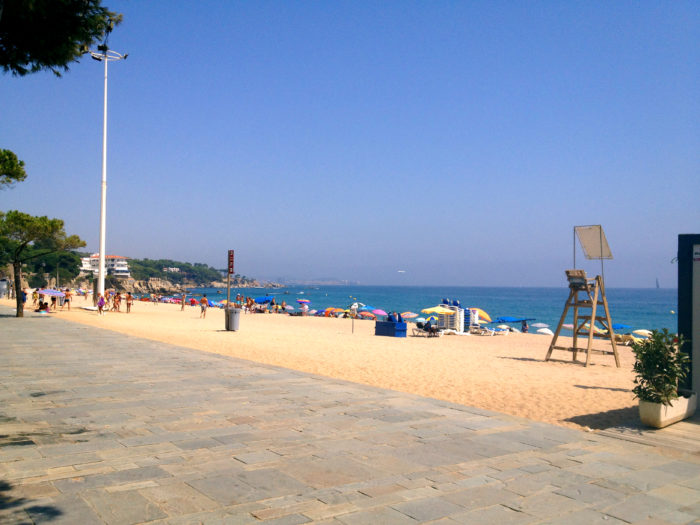
Platja d’Aro’s main beach. Photo by David Leigh.
Platja d’Aro is a great choice for anyone who loves the beach but also wants the advantages of a bustling town. Because Platja d’Aro is busy all year round for its high street which is full of shops, restaurants and bars. And in the summer there is plenty of nightlife too.
While the sand here is rather coarse, it is comfortable to lie on and doesn’t stick to your towel or feet! It may not be perfect for sand castles but then there are probably better beaches for kids anyway.
With a fairly steep slope the water quickly gets deep. A few metres from the shore you’ll be out of your depth.
If you prefer somewhere you can touch the bottom you might want to head for nearby Platja de Sant Pol. It’s past S’Agaró on the edge of Sant Feliu de Guíxols.
That said, let’s take an in-depth look at those beaches in Platja d’Aro.
Platja Gran – the main beach
The main beach in Platja d’Aro is one of the most popular on the entire Costa Brava.
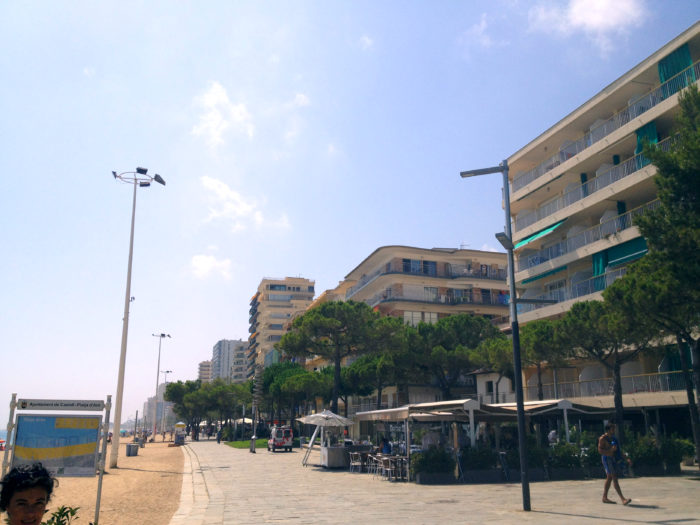
Platja d’Aro promenade. Photo by David Leigh.
This 2.4 km stretch of sand runs from the rocky Punta d’en Ramis down to the Ridaura river. An urban beach, it is large enough so that it doesn’t feel too crowded even at the height of the tourist season. The promenade runs along much of the length of the beach with a good selection of bustling restaurants and bars. Sit and relax in one of the comfortable bars sipping something cool after a day on the beach. What could be better?
The beach a has all the usual facilities you’d expect to find in a popular resort like Platja d’Aro and there’s a free car park five minutes away. Just take care not to leave your car there overnight on Thursday because the car park is used for the weekly market. The police will tow your car if it’s there when they set the market up on Friday morning.
At various points along the beach there are floating platforms anchored some 50 metres or so from the shore. You do need to be a confident swimmer though as they are anchored in several metres of water. They are good fun to swim out to and dive off though.
And if you’re looking to something different there is a regular tourist boat that departs right from the beach. During the summer it goes to various locations along the coast.
There are a couple of disadvantages though.
The first is that like the majority of beaches around here the shelf of the beach is quite steep and you don’t need to be far from the shore to be out of your depth. That makes it unsuitable for kids or anyone who isn’t a confident swimmer.
The second is that the beach loses the sun fairly early. A number of large apartment blocks stand just along behind the promenade and in the evening the sun disappears behind them.
Platja de Port d’Aro
This beach continues on from the main beach where it reaches the Ridaura river and ends at the marina’s sea wall.
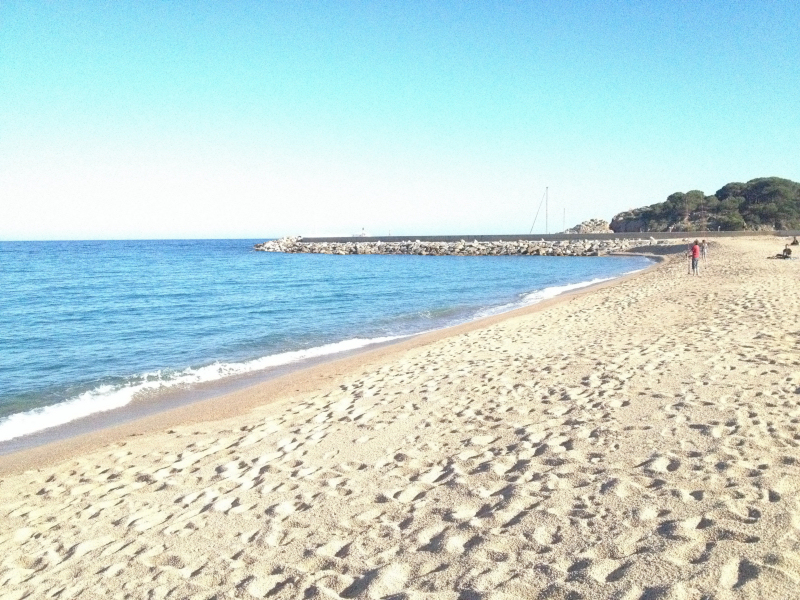
Platja de Port d’Aro. Photo by David Leigh.
You’d be forgiven noticing it was supposed to be a different beach. The river marking the boundary between Platja de Port d’Aro and Platja Gran only flows into the sea after torrential rainfall. Most most of the time the two beaches remain a continuous stretch of sand.
However the character of area is quite different. Instead of high-rise apartments behind the beach are a campsite and car park. Both are shaded by pine, with gives the beach an ambience that is far less urban. And without the monolithic apartment blocks the beach doesn’t lose the sun so early.
Often you see cormorants diving for fish here. It’s amazing how long they can stay submerged and the distance they cover underwater.
The beach has good facilities with proper toilets nearby and a lifeguard during the day, but the water still gets deep rather quickly and so not the best place for children.
Facilities include a restaurant, where they’ll also make sandwiches and provide ice cold cans of drink if you prefer to eat under your parasol. If you’re feeling energetic you can also go windsurfing from the area right next to the harbour wall and there is also a dive centre located on the beach near the Yacht Club.
Cala Rovira
Just north of Platja d’Aro’s beach is the 200 metre Cala Rovira, a sandy cove sandwiched between rocks at each end.
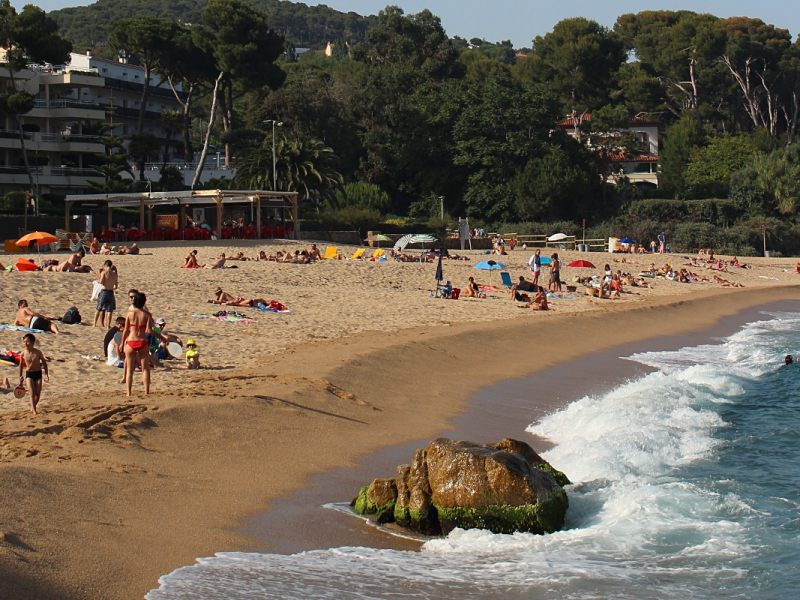
Cala Rovira. Cropped from photo by Albert Torelló.
To get there from the main beach go up the steps in the rock. If you continue past Hotel Costa Brava you’ll soon find yourself on another beach with the usual coarse sand. The beach has a lifeguard and is equipped with showers, toilets and a restaurant.
The nearby hotels can lend the beach a bit of a party atmosphere so if you’re looking for peace and quiet this may not always be the beach for you. But it isn’t as urban as the main beach and because it is quite deep you get the feeling of having more space because. If you like snorkelling then the rocks at each end are worth donning a face mask.
Rocky coves
Continue along the coastal path from Cala Rovira you’ll reach a couple of small, quiet coves that remain largely unspoilt.
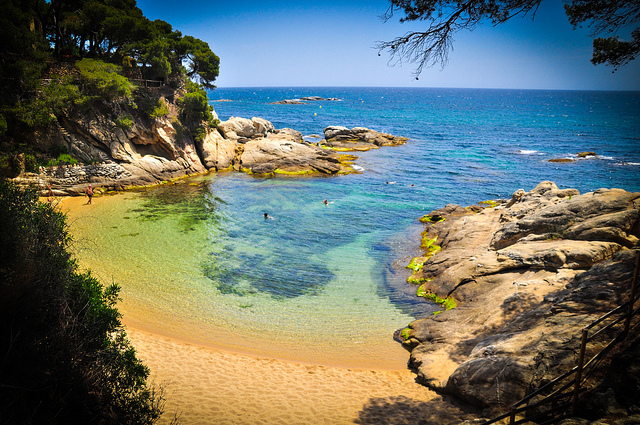
Cala sa Cova is a world away from Platja d’Aro’s main beach. Photo by Jordi Sanchez Teruel.
The first of these is the 50 metre Cala sa Cova but if you continue walking for five minutes you’ll get to the slightly larger Cala del Pi. It’s name comes from the pine trees that surround it.
Neither has any facilities but if you prefer uncrowded beaches in a more natural setting you won’t be put off by that. Platja d’Aro really looks and feels far away from either of these beaches.
Do you have any tips or advice about the beaches at Platja d’Aro? Or maybe you have a question.
Whatever it is, please leave a comment below and I’ll respond ASAP!


1 Comment
How much are the sunbeds and brill on the main beach?